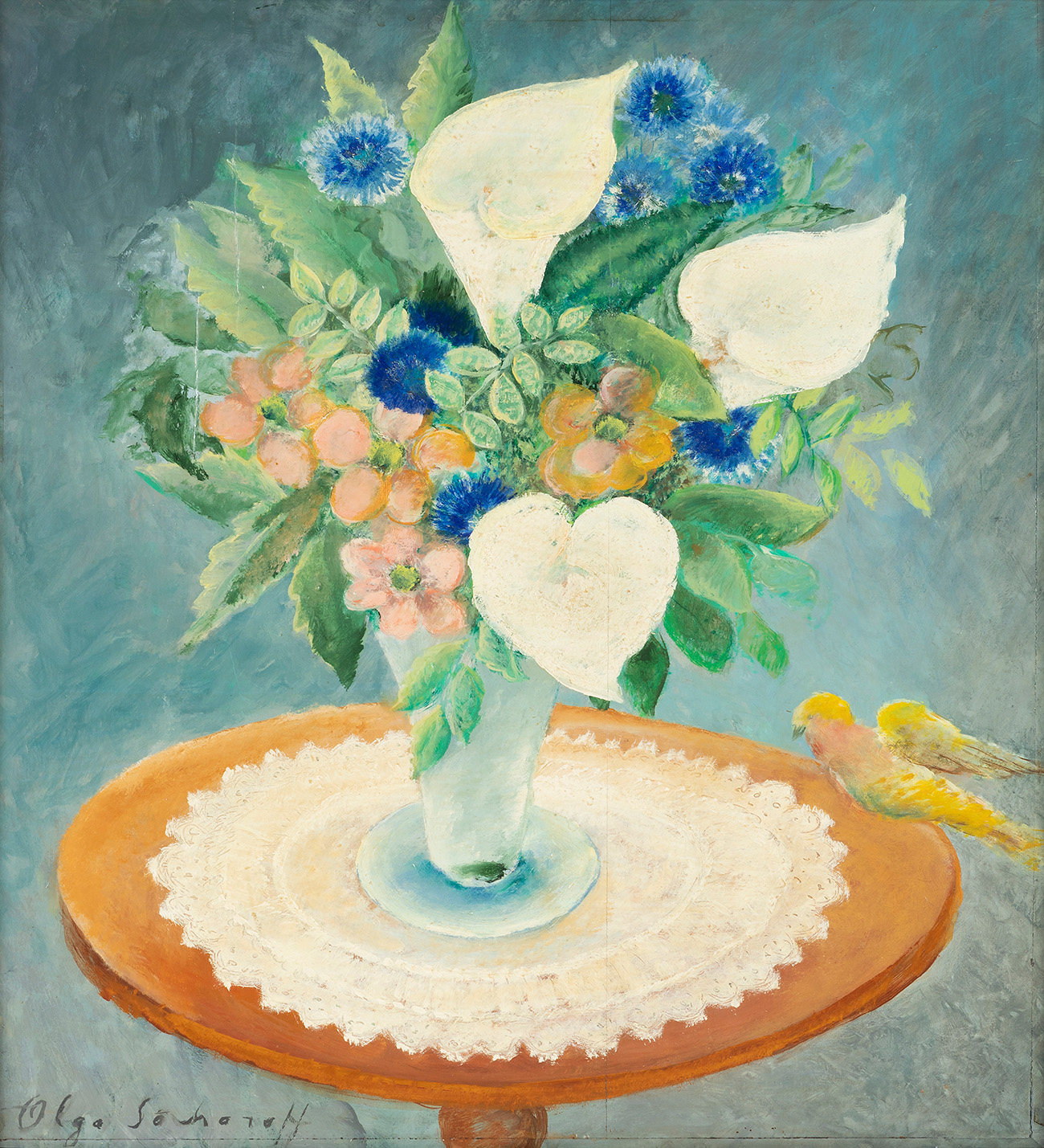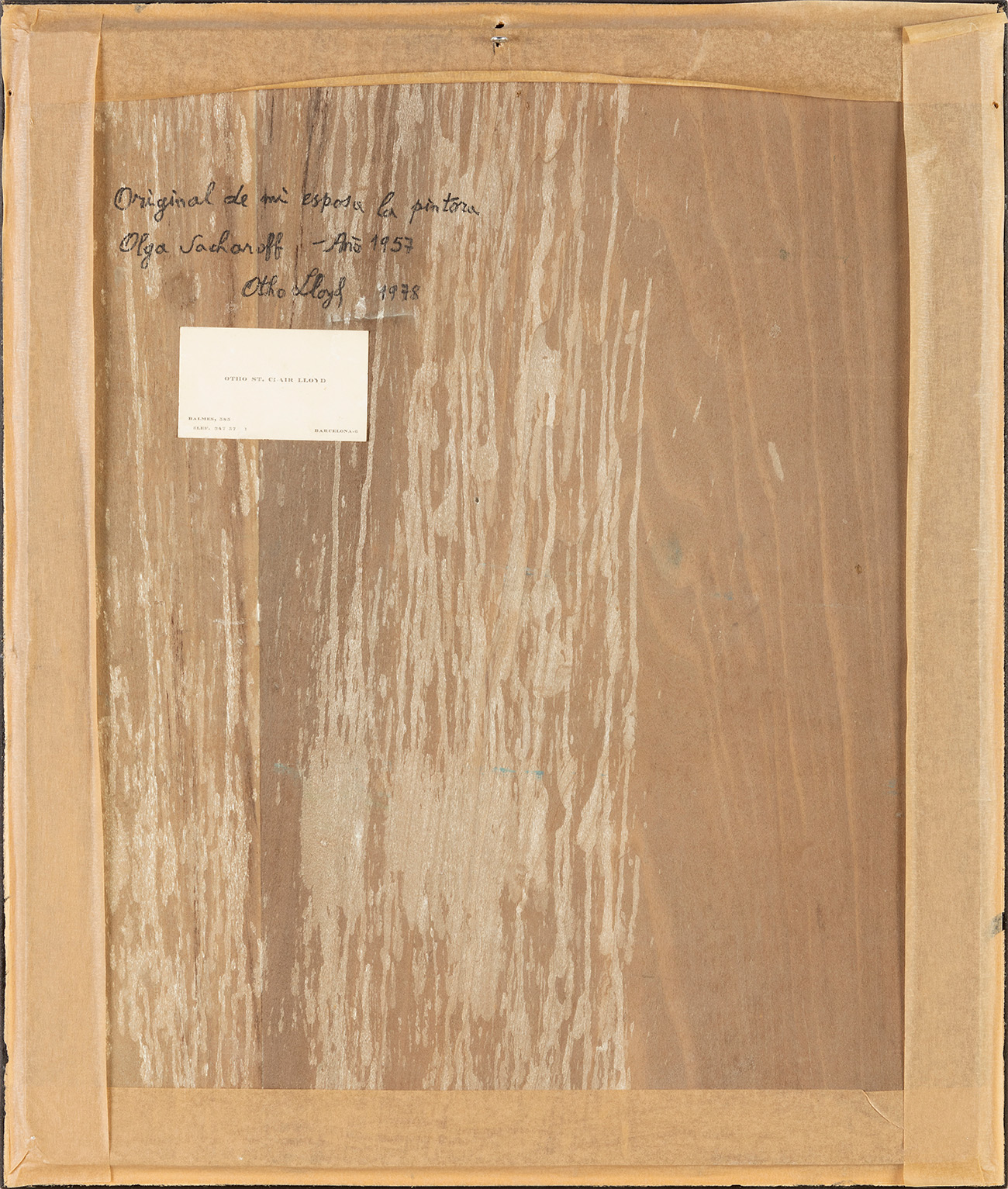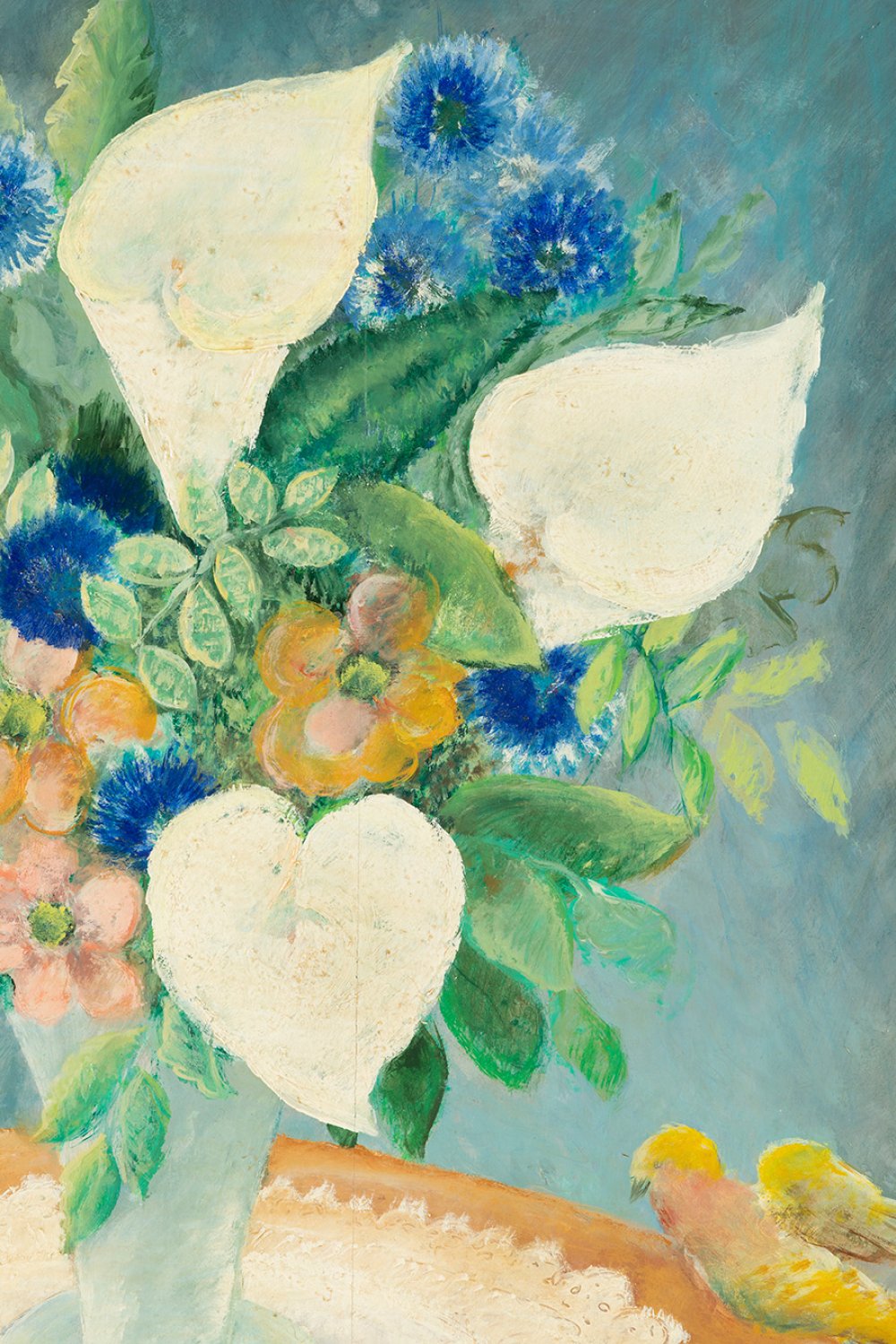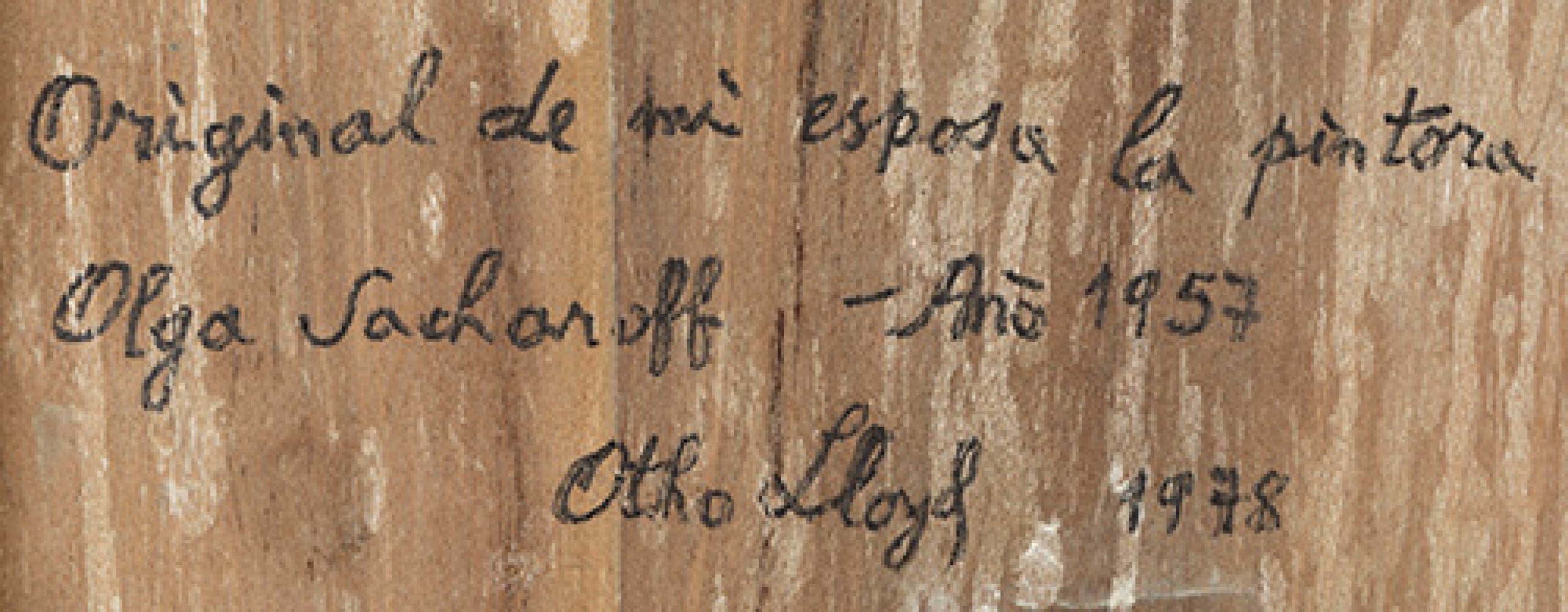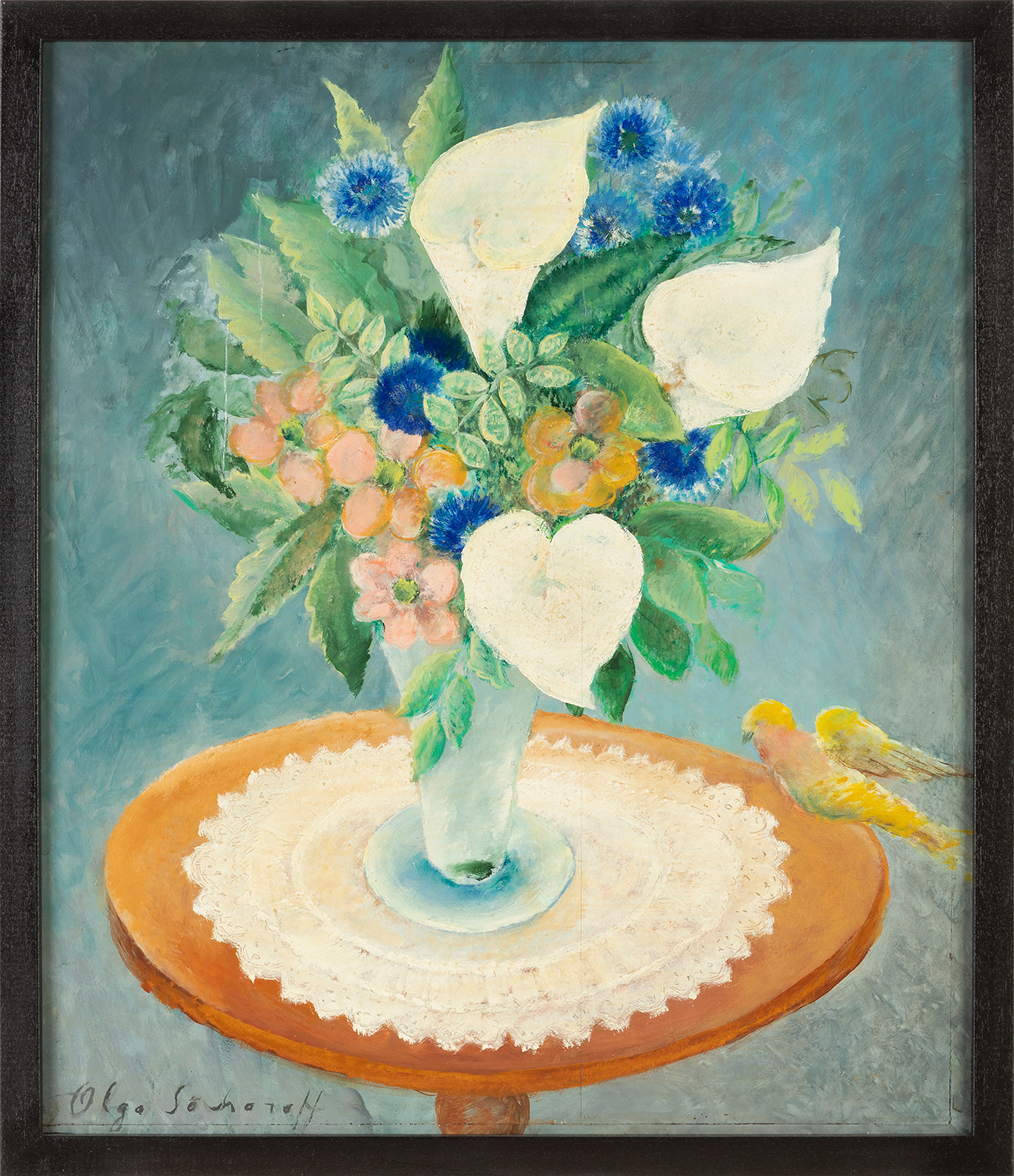12
OLGA SACHAROFF (Tiflis, Georgia, 1889 - Barcelona, 1967)."Flowers, 1957.Oil on panel.Signed in the
"Flowers, 1957.
Oil on panel.
Signed in the lower left corner.
Certified on the back by her husband Otto Lloyd in 1978.
Measurements: 55 x 46 cm; 58 x 49 cm (frame).
Olga Sacharoff's line takes on the delicacy of a fine tapestry. As a skilled seamstress she develops a filigree drawing, harmoniously combining flat and impressionistic colours, cold and warm, in balanced compositions. The white of the lace carpet is reflected in the bouquet, adding brightness, creating a welcoming and luminous atmosphere, the result of a careful study of nature, but distilling the forms to extract their essence.
After studying at the Tiflis School of Fine Arts, Sacharoff moved to Munich in 1910, where he came into contact with German Expressionism. The following year he moved to Paris, where his work was initially influenced by Cézanne, later evolving towards synthetic Cubism. At the outbreak of the First World War Sacharoff moved to Spain, where he settled in 1915, first passing through Majorca and finally settling in Barcelona the following year. In fact, some historians point out that she was the introducer of Cubism in Barcelona. From there she collaborated in Francis Picabia's magazine "391", considered the mouthpiece of Dadaism and published in Barcelona. He exhibited works at the Salons d'Automne in Paris in 1920, 1921, 1922 and 1928, receiving considerable praise from the press and managing to organise a solo exhibition in 1929 at the Parisian gallery Bernheim Jeune, one of the most important of the time. During these years she held an exhibition at the Galerías Layetanas in Barcelona (1934) and took part in the Montjuic Salon, of which she was appointed a member in 1935. When the Civil War broke out, Sacharoff returned to Paris, and in 1939 she exhibited at the Perls Gallery in New York. After the war he returned to Barcelona, leaving behind the avant-garde to immerse himself in a naïve taste close to Catalan noucentisme. His style took on lyrical and amiable features, and he placed himself at the service of an idealised vision of Catalonia: landscapes, customs, popular types, etc. In general, compositions with multiple characters predominate at this time, depicted with schematic strokes and vivid colouring. Chosen by Camón Aznar, he took part in the I Salón de los Once de Eugenio D'Ors (1943), held at the Biosca Gallery in Madrid. Two years later he organised a retrospective of his work in Paris, and in 1960 the Directorate General of Fine Arts devoted an anthological exhibition to him. In 1964 he was awarded the Medal of the City of Barcelona. Sacharoff also illustrated books, examples of which include Colette's "The House of Claudine" (1944) and Dostoyevsky's "Netochka Nezvanova" (1949). Recently an anthology was dedicated to her in a duo with María Blanchard in Bilbao (Sala de Exposiciones BBK, 2002). Olga Sacharoff is represented at the Mapfre Foundation in Madrid, the Reina Sofía National Centre, the Thyssen-Bornemisza Museum, the Casa Lis Art Nouveau and Art Deco Museum, the Marés Museum, the Pablo Gargallo Museum in Zaragoza and the Montserrat Monastery Museum, among many others.
"Flowers, 1957.
Oil on panel.
Signed in the lower left corner.
Certified on the back by her husband Otto Lloyd in 1978.
Measurements: 55 x 46 cm; 58 x 49 cm (frame).
Olga Sacharoff's line takes on the delicacy of a fine tapestry. As a skilled seamstress she develops a filigree drawing, harmoniously combining flat and impressionistic colours, cold and warm, in balanced compositions. The white of the lace carpet is reflected in the bouquet, adding brightness, creating a welcoming and luminous atmosphere, the result of a careful study of nature, but distilling the forms to extract their essence.
After studying at the Tiflis School of Fine Arts, Sacharoff moved to Munich in 1910, where he came into contact with German Expressionism. The following year he moved to Paris, where his work was initially influenced by Cézanne, later evolving towards synthetic Cubism. At the outbreak of the First World War Sacharoff moved to Spain, where he settled in 1915, first passing through Majorca and finally settling in Barcelona the following year. In fact, some historians point out that she was the introducer of Cubism in Barcelona. From there she collaborated in Francis Picabia's magazine "391", considered the mouthpiece of Dadaism and published in Barcelona. He exhibited works at the Salons d'Automne in Paris in 1920, 1921, 1922 and 1928, receiving considerable praise from the press and managing to organise a solo exhibition in 1929 at the Parisian gallery Bernheim Jeune, one of the most important of the time. During these years she held an exhibition at the Galerías Layetanas in Barcelona (1934) and took part in the Montjuic Salon, of which she was appointed a member in 1935. When the Civil War broke out, Sacharoff returned to Paris, and in 1939 she exhibited at the Perls Gallery in New York. After the war he returned to Barcelona, leaving behind the avant-garde to immerse himself in a naïve taste close to Catalan noucentisme. His style took on lyrical and amiable features, and he placed himself at the service of an idealised vision of Catalonia: landscapes, customs, popular types, etc. In general, compositions with multiple characters predominate at this time, depicted with schematic strokes and vivid colouring. Chosen by Camón Aznar, he took part in the I Salón de los Once de Eugenio D'Ors (1943), held at the Biosca Gallery in Madrid. Two years later he organised a retrospective of his work in Paris, and in 1960 the Directorate General of Fine Arts devoted an anthological exhibition to him. In 1964 he was awarded the Medal of the City of Barcelona. Sacharoff also illustrated books, examples of which include Colette's "The House of Claudine" (1944) and Dostoyevsky's "Netochka Nezvanova" (1949). Recently an anthology was dedicated to her in a duo with María Blanchard in Bilbao (Sala de Exposiciones BBK, 2002). Olga Sacharoff is represented at the Mapfre Foundation in Madrid, the Reina Sofía National Centre, the Thyssen-Bornemisza Museum, the Casa Lis Art Nouveau and Art Deco Museum, the Marés Museum, the Pablo Gargallo Museum in Zaragoza and the Montserrat Monastery Museum, among many others.
22nd September - 19th & 20th Century Art
Sale Date(s)
Venue Address
General delivery information available from the auctioneer
Setdart offers Worldwide shipping
PICK UP IN ROOM: You can come and pick up your lots in our offices (Barcelona, Madrid or Valencia). At the moment of the withdrawal, you will be able to accept the current conditions of the lot by means of a document that you will sign.
YOU CAN SEND ANOTHER PERSON TO PICK UP: This person must present a signed authorization that you can find in our web page by accessing from BUY AT SETDART- LOGISTICS-DOWNLOAD AUTHORIZATION DOCUMENT. You can also send an e-mail with the requested data in AUTHORIZATION DOCUMENT to admin@setdart.com
Important Information
25% buyer´s premium
21% buyer´s premium at www.setdart.com
Terms & Conditions
The maximum period to pay the lots is 7 working days. You can pay either via bank transfer or with credit card through our platform www.setdart.com (we only accept VISA or Mastercard).
BUYER´S PREMIUM: 22% Hammer price + 21% VAT from the buyer´s premium
If your piece has more than 100 years, our Ministry of Culture requires an export certificate in order for the piece to leave the country. Note that if the piece goes inside the EU, there is no cost for the export certificate. If the piece goes outside the EU, there is a cost for the export certificate. You can find more information in our Ministry of Culture website: https://www.culturaydeporte.gob.es/en/cultura/patrimonio/exportacionimportacion/exportacion/tasas.html
INQUIRIES: admin@setdart.com
Setdart guides you through the entire process, from the time of award to the day you receive your lot. Our logistics team will be happy to manage your transport, and will advise you on the best shipping method with professionals from the sector used to handling works of art and jewelry.
WE OFFER WORLDWIDE DOOR TO DOOR SHIPPING
PICK UP IN ROOM: You can come and pick up your lots in our offices. At the moment of the withdrawal, you will be able to accept the current conditions of the lot by means of a document that you will sign.
YOU CAN SEND ANOTHER PERSON TO PICK UP: This person must present a signed authorization that you can find in our web page by accessing from BUY AT SETDART-LOGISTICS-DOWNLOAD AUTHORIZATION DOCUMENT. You can also send an e-mail with the requested data in AUTHORIZATION DOCUMENT to admin@setdart.com
SETDART IS NOT RESPONSIBLE FOR THE STATE OF THE PARTS ONCE THEY LEAVE OUR FACILITIES. MRW SHIPMENTS: Once the payment is made, your lot will be packed for shipment, the logistics department will send you an e-mail notifying you of the day it leaves our warehouse, changes of address cannot be made after receiving this e-mail.
INSURANCE INCIDENTS: Coverage for the value of the auction up to 3000 ? per shipment, if the value of the auction is higher, Setdart will send you a quote including the additional insurance. The insurance company WILL NOT BE RESPONSIBLE FOR THE SHIPMENT THAT EXCEEDS THAT AMOUNT AND IS NOT FULLY INSURED. MRW INCIDENTS: Maximum notification 48 hours after receipt, after which the insurance company WILL NOT BE RESPONSIBLE AND NO CLAIMS WILL BE ACCEPTED.
E-MAIL LOGISTICS: logistica@setdart.com
PICK UP YOUR MESSAGES: You can send your own messaging, prior notice via e-mail that your shipment is ready, please note 3 or 4 days in advance. This type of shipment is packaged so Setdart will provide you with a quote.
EXPENSES FOR STORAGE: We inform you that if the purchased lot is not picked up within a month, you will be charged 30€ per week per lot. Setdart Online S.L., owner of the web site "setdart.com", "setdart.net" and "setdart.org", acts as a company of Spanish nationality inscribed in the Volume 36955, sheet 182, page B-293056 of the Mercantile Registry, with registered office at Calle Aragó













